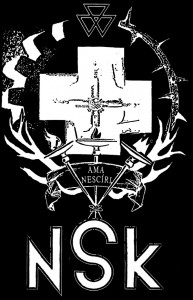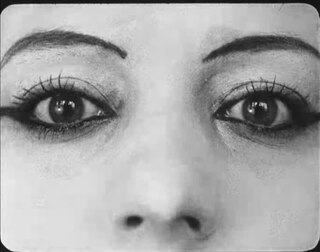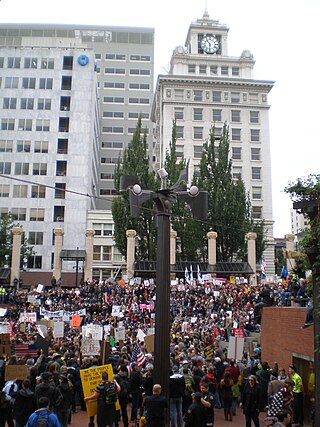
Dada or Dadaism was an art movement of the European avant-garde in the early 20th century, with early centres in Zürich, Switzerland, at the Cabaret Voltaire, founded by Hugo Ball with his companion Emmy Hennings, and in Berlin in 1917. New York Dada began c. 1915, and after 1920 Dada flourished in Paris. Dadaist activities lasted until the mid 1920s.

In the arts and in literature, the term avant-garde identifies an experimental genre, or work of art, and the artist who created it; which usually is aesthetically innovative, whilst initially being ideologically unacceptable to the artistic establishment of the time. The military metaphor of an advance guard identifies the artists and writers whose innovations in style, form, and subject-matter challenge the artistic and aesthetic validity of the established forms of art and the literary traditions of their time; thus, the artists who created the anti-novel and Surrealism were ahead of their times.

Neue Slowenische Kunst is a political art collective that formed in Slovenia in 1984, when the Socialist Republic of Slovenia was part of Socialist Federal Republic of Yugoslavia. NSK's name was chosen to reflect the theme in its works of the complicated relationship Slovenes have had with Germans. The name of NSK's music wing, Laibach, is also the German name of the Slovene capital Ljubljana. The name created controversy because some felt it evoked memories of the Nazi annexation of Slovenia during the Second World War. It also refers to Slovenia's previous seven centuries as part of the Habsburg monarchy.

Postmodern art is a body of art movements that sought to contradict some aspects of modernism or some aspects that emerged or developed in its aftermath. In general, movements such as intermedia, installation art, conceptual art and multimedia, particularly involving video are described as postmodern.

Experimental film or avant-garde cinema is a mode of filmmaking that rigorously re-evaluates cinematic conventions and explores non-narrative forms or alternatives to traditional narratives or methods of working. Many experimental films, particularly early ones, relate to arts in other disciplines: painting, dance, literature and poetry, or arise from research and development of new technical resources.

Harold Foss "Hal" Foster is an American art critic and historian. He was educated at Princeton University, Columbia University, and the City University of New York. He taught at Cornell University from 1991 to 1997 and has been on the faculty at Princeton since 1997. In 1998 he received a Guggenheim Fellowship.

Anti-art is a loosely used term applied to an array of concepts and attitudes that reject prior definitions of art and question art in general. Somewhat paradoxically, anti-art tends to conduct this questioning and rejection from the vantage point of art. The term is associated with the Dada movement and is generally accepted as attributable to Marcel Duchamp pre-World War I around 1914, when he began to use found objects as art. It was used to describe revolutionary forms of art. The term was used later by the Conceptual artists of the 1960s to describe the work of those who claimed to have retired altogether from the practice of art, from the production of works which could be sold.

Stanislav Vinaver was a Serbian writer, poet, translator and journalist. Vinaver was born to affluent Ashkenazi Jewish parents that had immigrated to Serbia from Poland in the late 19th century. He studied at the University of Paris, volunteered to fight in the Balkan Wars and later took part in World War I as an officer in the Royal Serbian Army. In 1915, he lost his father to typhus. He travelled to France and the United Kingdom the following year, delivering lectures about Serbia and its people. In 1917, he was assigned to the Serbian consulate in Petrograd, where he was to witness the Russian Revolution and its aftermath.

Croatian art of the 20th century, that is visual arts within the boundaries of today's Croatia, can be divided into modern art up to the Second World War, and contemporary art afterwards.
In the visual arts, late modernism encompasses the overall production of most recent art made between the aftermath of World War II and the early years of the 21st century. The terminology often points to similarities between late modernism and postmodernism, although there are differences. The predominant term for art produced since the 1950s is contemporary art. Not all art labelled as contemporary art is modernist or post-modern, and the broader term encompasses both artists who continue to work in modern and late modernist traditions, as well as artists who reject modernism for post-modernism or other reasons. Arthur Danto argues explicitly in After the End of Art that contemporaneity was the broader term, and that postmodern objects represent a subsector of the contemporary movement which replaced modernity and modernism, while other notable critics: Hilton Kramer, Robert C. Morgan, Kirk Varnedoe, Jean-François Lyotard and others have argued that postmodern objects are at best relative to modernist works.

Lumino Kinetic art is a subset and an art historical term in the context of the more established kinetic art, which in turn is a subset of new media art. The historian of art Frank Popper views the evolution of this type of art as evidence of "aesthetic preoccupations linked with technological advancement" and a starting-point in the context of high-technology art. László Moholy-Nagy (1895–1946), a member of the Bauhaus, and influenced by constructivism can be regarded as one of the fathers of Lumino kinetic art. Light sculpture and moving sculpture are the components of his Light-Space Modulator (1922–30), One of the first Light art pieces which also combines kinetic art.
The Marinko Sudac Collection, based in Zagreb, Croatia, has been created with a clear collecting strategy based on the region of Central and Eastern Europe, additionally spanning from the Baltic area to the Black Sea. The guiding principle of the Collection is systematic exploration, researching, and promotion of the avant-garde practices which have been marginalized, forbidden, and at times completely negated due to the historical, social and political circumstances. In this context, the Marinko Sudac Collection gives the most complete and comprehensive overview on the art of this region. The Collection starts at 1909, and it show the continuity from the first Avant-Gardes, through neo-avant-garde and New Artistic Practices, ending with the fall of the Berlin Wall. The global uniqueness of the Marinko Sudac Collection is also seen in the kind of media it contains. It contains not only traditional artworks, such as paintings, sculptures, and photographs, but it gives equal importance to documentary and archival material. Great importance is put on these almost forgotten media, which enable research of specific phenomena, artists and the socio-political situation which affected this type of art. The Collection contains a great number of museological units, and it treats the documentary and archival material on the same level as traditional artworks. By examining the units contained in the Marinko Sudac Collection, one can read not only the art scene or the art production of a certain artist, but the full status of the society, the socio-political atmosphere of the region in which this art was created in.
Post-socialist art or post-communist art is a term used in analysis of art arriving from post-socialist (post-communist) countries taken as different in their nature from Western, Postmodern art.
Experimental rock, also called avant-rock, is a subgenre of rock music that pushes the boundaries of common composition and performance technique or which experiments with the basic elements of the genre. Artists aim to liberate and innovate, with some of the genre's distinguishing characteristics being improvisational performances, avant-garde influences, odd instrumentation, opaque lyrics, unorthodox structures and rhythms, and an underlying rejection of commercial aspirations.
Josip Seissel was a Croatian architect and urban planner, who under the pseudonym of Jo Klek was a constructivist artist, graphical designer and theatrical designer. A member of the influential avant-garde Zenit movement of the 1920s, he is considered to be a pioneer of surrealism and abstract art in Croatia.

Marina Gržinić is a philosopher, theoretician, and artist from Ljubljana. She is a prominent contemporary theoretical and critical figure in Slovenia. Since 1993, she is employed at the Institute of Philosophy at the Scientific and Research Center of the Slovenian Academy of Science and Arts. Today, she serves as a professor and research adviser. For her scientific work, she received the Golden SASA sign in 2007. Since 2003, she has also served as a Full Professor at the Academy of Fine Arts in Vienna, Austria. She publishes extensively, lectures worldwide, and is involved in video art since 1982.
Neo-Dadaism Organizers, sometimes shortened to Neo-Dada Organizers or simply Neo-Dada (ネオ・ダダ), was a short-lived but influential Japanese Neo-Dadaist art collective formed by Masunobu Yoshimura in 1960. Composed of a small group of young, up-and-coming artists who met periodically at Yoshimura's "White House" atelier in Shinjuku, the Neo-Dada Organizers engaged in all manner of visual and performance artworks, but specialized in producing disturbing, impulsive spectacles, often involving physical destruction of objects, that the art critic Ichirō Hariu deemed "savagely meaningless," and that inspired another art critic, Yoshiaki Tōno, to coin the term "anti-art" (han-geijutsu). Examples included filling galleries with piles of garbage, smashing furniture to the beat of jazz music, and prancing the streets of Tokyo in various states of dress and undress. Using the human body as their medium of art, their violent performances reflected both their dissatisfaction with the restrictive environment of the Japanese art world at the time, as well as contemporary social developments, most notably the massive 1960 Anpo protests against the U.S.-Japan Security Treaty.
Miloš Golubović was a Serbian artist, who during the Great War, was already an accomplished and acclaimed painter.
Mihajlo S. Petrov (1902-1983) was a Serbian-Yugoslavian avant-garde painter, graphic artist, illustrator, etcher, and art critic.

Dada Tank was a Yugoslav Dadaist single issue publication published in Zagreb in June 1922 and edited by Dragan Aleksić. Aleksić published Dada Tank as a response to Branko Ve Poljanski and his brother Ljubomir Micić's anti-Dada publication Dada-Jok from May 1922.











